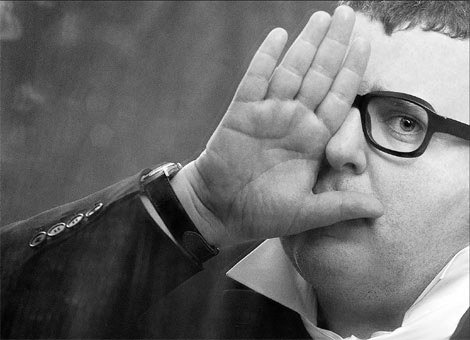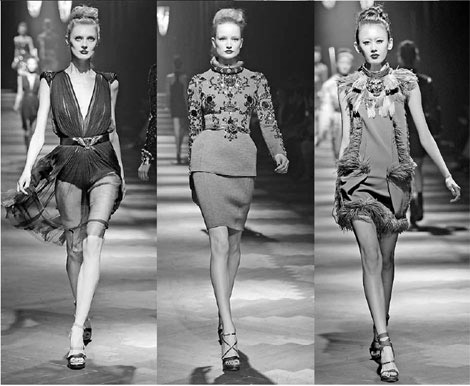

 |
|
Elber Albaz celebrates his 10th anniversary working for French luxury house Lanvin in Beijing with a showcase of his creations fusing the label's rich heritage with his unique slim cuts and bold colors. Photos provided to China Daily |
Designer Elber Albaz puts his best fashions forward, not his face, he tells Gan Tian.
Consider the famous fashion designers around the world. Marc Jacobs shows off his muscles from time to time, Tom Ford loves to be elegant, John Galliano is famous for his feminine style, but Elber Albaz is shy and easy-going. Wearing his typical black-framed glasses and black bow tie, Albaz has come to Beijing for a celebration of his 10th year working for French luxury label Lanvin. The event featured a Lanvin show featuring Albaz's creations, and an after-party for his private clients. It was lit up by the country's A-listers, including entertainers Fan Bingbing and Ni Ni, actor Simon Yam, supermodels Du Juan and Pei Bei, as well as Japanese football celebrity Nakata Hidetoshi.
For the exclusive interview with China Daily, Albaz pulls over a chair casually, sits like a child, and listens intently to every question. When appearing in public, he never seems as fabulous as Jacobs, Ford or Galliano. He has his own explanation.
"There is a big problem with fashion today," Albaz says. "Sometimes fashion designers become very much like stars. But we are not stars. The real stars are clothes and people.
"They always say that a shoemaker does not wear shoes. I have my uniform, which is very simple. I don't get crazy with dresses. I always wear black and white pieces. I'm not important. What is important is the dress, the woman, not me, so I have to be out of the picture," the designer says.
Albaz was born in Morocco in 1961. At the age of 26, he went to New York, working for Geoffrey Beene, which influenced him in the draping techniques.
Since then, Albaz has expanded his career path in fashion industry. Later, he worked with French couture house Guy Laroche in 1996, designing women's ready-to-wear for Yves Saint Laurent in 1998.
He took over Lanvin, becoming its creative director in 2001. Fusing the label's rich heritage with his own unique slim cuts and bold colors, he has made Lanvin one of the most successful luxury brands in the world.
"To be frank, I don't know why I chose Lanvin and stayed here for 10 years. I found my home at Lanvin somehow. I feel like I have a loyalty with this label," Albaz says.
He frequently describes his work for Lanvin as "classic with a twist". Albaz has created many tracksuits for evening and dresses that have ribbons and pleats pinned to them. His creations create an urgent and spontaneous mood for the wearers.
"When I do the fabrics, I work with a model, a real woman, not with a paper," he says, illustrating one secret to his success.
But Albaz never has a muse when creating a dress for women, he admits.
"Muses are very old-fashioned, and they exist in the past. They are very limited, but the fashion world is becoming more democratic. No matter how old she is or what body she has, a woman can always wear my dress," he says.
Albaz never struggles to puzzle out the relationship between a fashion designer and fashion. He compares a fashion designer with a perfume. You can smell perfume, but you'll never drink it.
"I only smell the fashion, I don't drink it. I leave it to the rest of the people. I love fashion, and I love fashion people, but my job is to produce it. It is the same with my philosophy in dresses," he adds.
This is Albaz's second time in China. The first was almost 10 years ago, and it has changed a lot in his eyes. The most impressive thing for him is that when he hugs Chinese strangers in the street, they hug him back.
"I enjoyed Chinese fashion. It is very modern and energized. That is what I found this time: All that we are looking for is to be hugged, to be loved," Albaz says. "We need it also in fashion. I give love back to them by letting them enjoy beautiful clothes."